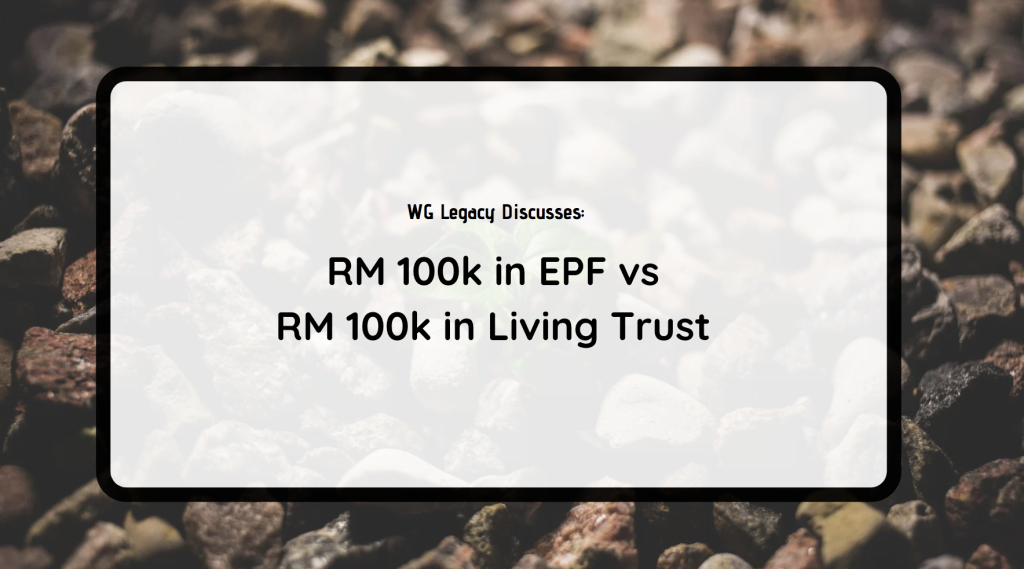In my previous write-up, I’d listed down 3 differences between holding our cash in FD accounts and in a living trust. Once again, I believe it is worth taking notes that the purpose is not to say that one is better than the other. I believe both of them have their own attributes and significance in financial planning.
But, what about EPF?
How is placing cash in EPF different from placing money in living trust?
As such, in this write-up, I’ll share 3 key differences between placing cash in EPF and placing cash in a living trust. They are as follows:
Difference #1: Methods of Distribution
Let’s say, we have Mitch, a 60-year old business coach based in Subang Jaya. He has RM 200,000 in excess cash and he chooses to place as much as RM 100,000 into his EPF account and the remaining RM 100,000 in a living trust. A few years later, he passed away. As such, the question is, ‘What would happen to the cash placed in his EPF account and in his living trust?’
EPF:
Let’s say, Mitch had nominated his wife and two children to be the beneficiaries of his EPF money. As such, his EPF money, including the RM 100,000 placed into it, shall be distributed to his wife and two children in one lump-sum upon death and this is provided that his children had reached 18 years old. His beneficiaries could then use the proceeds received in accordance with their intentions which may include funding of living expenses, children’s tertiary education fees, down payment for houses, wedding expenditures, and so on and so forth.
Living Trust:
Similarly, Mitch could nominate his wife and his two children to be beneficiaries of his living trust. In his trust deed, Mitch could choose to instruct his trustee to distribute the money within based on his preferred frequency, amount, and the purpose of distribution. This will be useful if Mitch wishes to have a say in ‘how, what and when’ the money is to be utilized upon his death.
Here is an example:
Let’s say, Mitch has a child who is a minor. He wishes to prepare as much as RM 100,000 in funds to pay for his child’s tertiary education fees. Hence, in his trust deed, Mitch could instruct his trustee to utilize his RM 100,000 in his living trust to pay for his child’s college or university fees. If the fees are below RM 100,000 and his child has completed his tertiary education, Mitch could then instruct his trustee to pay out all remaining balance to his child upon his graduation.
Hence, this would limit the possibility of fund mismanagement by beneficiaries.
Difference #2: Fundings for the Physical and Mental Incapacitated
Once again, as explained in my previous write-up, the money placed in FDs, EPF and living trust will continue to be intact. But, the accessibility of cash would be the main concern and hence, could be the difference maker, in the event of one person becoming incapable of managing his financial affairs in the future.
EPF:
Yup, Mitch is eligible to withdraw money from his EPF to fund both medical and living expenses if he is critically ill, totally and permanently disabled or one who becomes mentally disabled. But, the questions are:
a. Will Mitch be the one to apply for his EPF withdrawal?
b. Can he get access to his EPF money if the money is banked into his account?
c. What if Mitch loses his ability to do any of the two stated above?
Here is some food for thought:
What is the point of one having RM 10 million in FDs and probably, another RM 10 million in EPF, if he loses his ability to get access and manage them himself?
Living Trust:
Mitch could nominate himself to be a beneficiary of his own living trust and can instruct his trustee to fund his medical and living expenses from his cash placed within his living trust. The access lies with his trustee, not Mitch. Therefore, the money placed within his living trust could act as a life saver to Mitch.
Difference #3: What if Mitch is Healthy and Alive?
Once again, this is a test of productivity of Mitch’s money:
EPF:
EPF has built a portfolio comprising fixed income assets, equities, and as well as real estates. EPF had averaged 6.1% per annum in dividend yields in 2011-2020. Thus, like all EPF members, Mitch would continue to earn yearly dividends from his EPF accounts as long as he maintains his balances inside.
Living Trust:
As discussed in my previous write-up, Mitch could decide if he wants his money placed in his living trust to be invested or otherwise. Subsequently, if the cash is to be invested, Mitch could choose either to decide on his investment products, or to delegate this decision to his preferred trustee. Hence, the returns from his cash placed in his living trust is really dependent on Mitch’s decision on how his money would be invested.
Conclusion: Is Living Trust Better than EPF?
Once again, the answer is nope.
Historically, EPF has a track record of delivering stable dividends to its members and is a popular vehicle for contributors to grow and keep their retirement nest eggs. In addition, EPF has some basic estate planning features which could offer financial support to members’ beneficiaries in the event of death, disability and critical illnesses.
Whereas, living trust is intended for estate planning where a person can choose to distribute the cash within his trust in accordance with his personal objectives and thus, assure that his money would be utilized purposefully. So, a living trust is set up to fill in this gap and thus, add to one’s financial security.
So, how can I get started in setting up my own living trust?
If you wish to do so, you may book yourself a 30-minute consultation session to find out how you could set up your own living trust. To do so, please fill up your details below:




